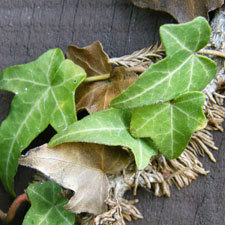 English Ivy
English Ivy
Common name: English Ivy
Botanical name: Hedera helix
Management programme: Sustained control - Rule 5a applies
Originates from Europe, North Africa, Tropical and Subtropical Asia. Introduced to New Zealand as an ornamental garden plant.
Why is it a pest?
- Clings to and climbs almost any surface, can grow over the forest floor, sub-canopy, and canopy to great heights, forming dense, long-lived masses at a moderate to fast growth rate and completely smothering tree trunks and branches.
- Ivy can smother and kill all plants from ground level to canopy, destroying vulnerable epiphyte niches, and preventing regeneration of native plant seedlings.
- The weight of ivy infestation can bring down branches or whole trees.
- The sap can cause contact dermatitis in some people.
Where is it found?
Ivy is established throughout the Bay of Plenty. It is generally found near inhabited areas or where vegetation has been dumped on roadsides and reserves.
Birds readily spread the seed when it is produced, but most spread is through pieces dumped with green waste.
What does it look like?
- Rampant, evergreen climber with stout woody stems that become erect at flowering, attaching to whatever is supporting it with aerial rootlets.
- Hairless dark green or variegated ivory-white leaves are variably shaped. Large leathery leaves (3–15 cm long) have seven to nine deep lobes like fingers of a hand or a maple leaf.
- Tiny, insignificant yellowish-green flowers are produced from March to May, followed by purple to black berries containing seeds with low viability.
- Plants have a tap root when young and broad spreading roots when mature.
What are the rules?
Sustained control
Sustained Control pests are well established in the region and preventing the spread is no longer a realistic objective. Management focuses on reducing general impacts of the pest. Landowners/occupiers are responsible for the control of these pest species on their land. Council may enforce control.
Under rule 5a of the RPMP landowners/occupiers must destroy this pest if required by a written direction from an authorised person unless a property specific pest management agreement has been agreed and signed between the occupier and the Council.
Criteria to meet Rule 5A include when the species is being actively managed by council, other agency and or community group, on an adjacent property. See the Regional Pest Management Plan 2020-2030 rules for Sustained control pests for more information.
How to get rid of it
Recommended:
- Stump treatment can be conducted year around using metsulfuron gel or granules (5g/1L) or Tordon BK (50ml/1L). Ensure that all stems are cut of at ground level and pasted liberally. Vines can be left in the tree to die off so long as they are not in contact with the ground.
- Spraying is best completed in summer using metsulfuron-methyl (5g + 10ml penetrant/ 10L).
Dispose of any plant and root material at the refuse station in general waste. Continue hand pulling seedlings as they grow and controlling new growth until the area is fully clear.
CAUTION: When using any herbicide or pesticide, PLEASE READ THE LABEL THOROUGHLY to ensure that all instructions and directions for the purchase, use and storage of the product, are followed and adhered to.
Read more on pest control advice, information and regulations.
Images




